How to install a heater on the faucet: the rules of work
In the XXI century, the absence of hot water in the house is most likely viewed as nonsense, and not the rule, so if you do not have a gas column or an electric boiler, there is a way out of the situation - this is a faucet with a built-in heater running on AC power. current voltage 220V.
That is, such parameters make the mechanism more than affordable, since it can be connected to any outlet in our house or apartment. Below we will learn a little more about such cranes, the method of their installation and addition to your attention will be presented a demonstration of the video in this article.
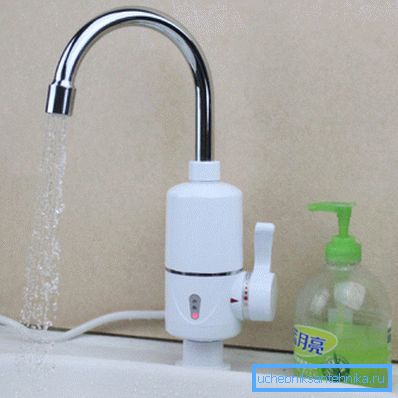
Hot tap water
How it works
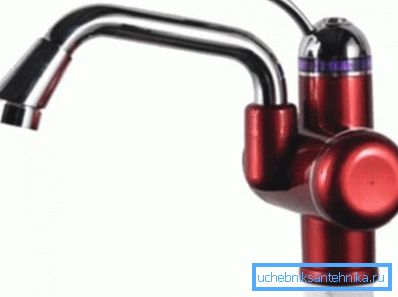
- First, let's understand what a faucet on a flow heater is, more precisely, what it consists of and how it functions (heats water). In appearance, the mechanism is very similar to a single-lever mixer, only the dimensions in this case are slightly larger than usual and there is such an addition as an electrical cord with a plug and a RCD built into it.
- The lever knob has three main points:
- In the middle - turned off;
- To the right - cold water flow;
- To the left - hot water stream.
- But at the same time, the left-to-left modes do not have a clear fixation, that is, the more you move the lever to one side, the stronger the water pressure becomes. But the hot mode with increasing pressure loses temperature, so when fully opened, the water will not be hotter than 30-40? C, but if the flow is minimal, then the temperature can even reach 70? C.
- In addition, the temperature of hot water can be regulated by special devices, so in some models this is done with a central handle (lift it up and down), and in others there is a small lever on the side (this is much more convenient, but the price can be slightly higher).
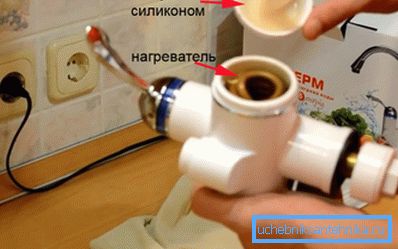
- The water inside the mechanism is heated using an electric heating element, which is marked by an arrow in the top photo, and it is closed with a plug with a silicone gasket. In the case of freezing of water in the faucet, a silicone gasket will serve as a buffer and the casing will not break (this is very convenient for summer cottages where there is no constant heating of the building). Also, there is protection against voltage surges - it is a protective cutout or RCD device.
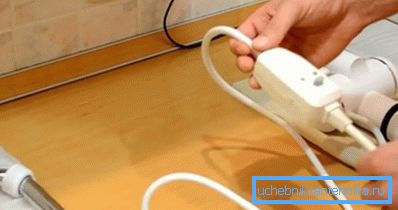
Note. As you understand, different models may differ, although all of them are very similar to each other, but each of them has instructions for installation and operation.
Installation
Note. In this case, we will install a fairly popular model of instantaneous (flow-through) heating of AQUATERM (AQUATERM), which operates under conditions of minimum water pressure 0.4 atm (0.04 MPa) and maximum - 7.0 atm (0.7 MPa). TEN at this modification joins automatically at a temperature below 60? C.
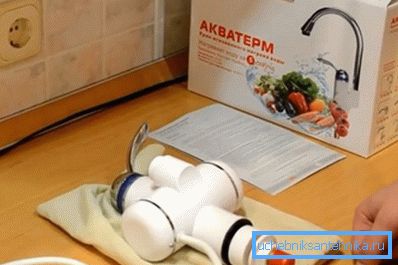
AQUATERM operates on AC 220V 50Hz and can consume 2.5-3.0 kW / h. The rate of heating of the jet by the heater is about 4-5 seconds. The efficiency of the flow heater is determined by the burning red light on the RCD.
Of course, the first thing to do is to remove the old faucet from the sink or sink and wipe the seat well - there, most likely, lime scurf has gathered around the edges of the hole. Then we unpack the running water heater on the faucet - the kit consists of the main mechanism with an electric cord and a RCD, a spout (spout) and a technical passport.
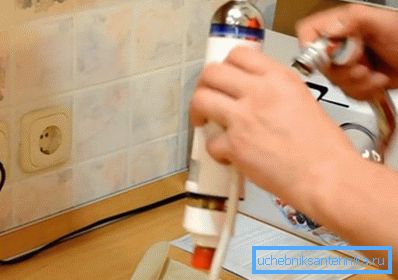
Now we need to install and fix the spout on the heating faucet for water - this installation is practically no different from homogeneous actions for a conventional sink faucet. At the recessed end of the spout there is a special sealing gasket that fits into the groove there, and you will need to insert this end into the body so that the gasket fits on the groove in the body.
When it reaches its location, you will feel something like a click - then tighten the locknut until it stops with your hands (a wrench or pliers are not recommended in this case).
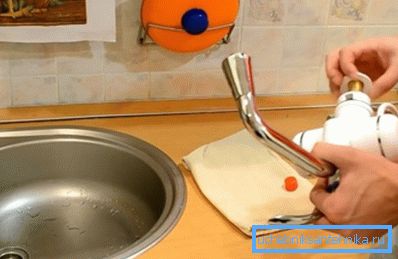
Now we need to unscrew the locknut from the body connecting pipe and remove it together with the washer - while the rubber gasket should remain on the body to seal the joint with the sink (sink) - it is usually black.
Here, the method of attachment differs from conventional mixers, which in most cases are fixed to the sink with two studs with nuts and a shaped metal washer. Although some models also occasionally fasten with a single lock nut.

Then everything is very simple - you insert the water heater valve into the fitting hole of the sink or sink - while you need to try so that the lever switch in the neutral (off) position indicates a drain in the bowl - this is the way to center it.
Now, holding the installed model with one hand, put the washer on the bottom with the other hand and tighten the lock nut - in this case it is not necessary to use any key either - manual tightening will be enough provided that it is made by a strong man.
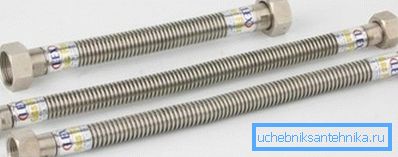
If the kit includes a hose for connecting to the water supply, then it is most likely rubber in a metal braid (screen) and such tubes are not of high quality - the braid is rusting and in this place the rubber bulges and then bursts. It is best to buy in the store a metal corrugated hose of the desired length with internal thread nuts or a piece of metal-plastic pipe with the right fittings.
Even if you have a female threaded fitting on the plumbing, then screw a barrel in there - if the tube is screwed with two nuts with BP, then it is not twisted, therefore, its operational life increases.
Shut off the hot water pipe and check the operation of the valve without connecting it to the mains (turn the handle in different directions to make sure that the throughput is good).
Then plug in the power cord and look at the RCD - if a red light flashes there, then everything works. Open the water and check the heating capabilities of the unit.
Conclusion
As you can see, installing a flow-through heating valve with your own hands is not difficult if you follow all the recommendations. It should also be noted that this unit does not apply to the type of mixers, as it consumes only cold water, therefore, there is nothing mixed.